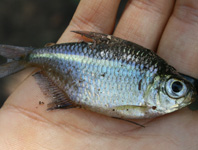Abstract
We sampled snakes of the genus Xenochrophis from across Northeast India. The snakes were evaluated for both morphological and molecular parameters. Phylogenetic relationship was reconstructed using mitochondrial genes (Cytb, 12s rRNA, ND4). The genus Xenochrophis was found to be paraphyletic, X. piscator complex and X. punctulatus form a single clade with Atretium schistosum as their sister taxon. X. cerasogaster forms a distinct lineage. X. vittatus and X. trianguligerus are related to the genus Rhabdophis. Herein it is recommended that X. piscator complex, i.e. X. asperrimus, X. flavipunctatus, X. melanzostus, X. piscator, X. sanctijohannis, X. schnurrenbergeri and X. tytleri, as well as X. punctulatus be reallocated to the genus Fowlea
References
Are´valo, E., Davis, S.K. & Sites, J.W. (1994) Mitochondrial DNA sequence divergence and phylogenetic relationships among eight chromosome races of the Sceloporus grammicus complex (Phrynosomatidae) in Central Mexico. Systematic Biology, 43, 387–418.
https://doi.org/10.1093/sysbio/43.3.387Boulenger, G.A. (1893) Catalogue of the snakes in the British Museum (Natural History), Vol. I., containing the families Typhlopidae, Glauconiidae, Boidae, Ilysiidae, Uropeltidae, Xenopeltidae, and Colubridae Aglyphae, part. British Museum of Natural History, London, xiii + 448 pp., 28 pls.
Crump, M.L. & Scott, N.J. (1994) Visual encounter surveys. In: Heyer, W.R., Donnelly, M.A., McDiarmid, R.W., Hayek, L.C. & Foster, M.S. (Eds.), Measuring and Monitoring Biological Diversity: Standard Methods for Amphibians. Smithsonian Institution Press, Washington, D.C., pp. 84–92.
Dowling, H.G. & Savage, J.M. (1960) A guide to snake hemipenis: a survey of basic structure and systematic characteristics. Zoologica, 45, 17–28.
Dowling, H.G. (1951) A proposed standard system of counting ventrals in snakes. British Journal of Herpetology, 1, 97–99.
Dubey, B., Meganathan, P.R., Vidal, N. & Dubey, I.H. (2012) Molecular evidence for the nonmonophyly of the Asian natricid genus Xenochrophis (Serpentes: Colubroidea) as inferred from mitochondrial and nuclear genes. Journal of Herpetology, 46, 263–268.
https://doi.org/10.1670/10-116Günther, A.C.L.G. (1864) The Reptiles of British India. Ray Society, London, xxvii + 452 pp., 26 pls.
Kumar, S., Stecher, G. & Tamura, K. (2016) MEGA7: Molecular Evolutionary Genetics Analysis Version 7.0 for Bigger Datasets. Molecular Biology and Evolution, 33, 1870–1874.
https://doi.org/10.1093/molbev/msw054Kumazawa, Y. & Endo, H. (2004) Mitochondrial genome of the Komodo Dragon: efficient sequencing method with reptile-oriented primers and novel gene rearrangements. DNA Research, 11, 115–125.
https://doi.org/10.1093/dnares/11.2.115Lambert, M.R.K. (1984) Amphibians and reptiles. In: Cloudsley-Thompson, J.L. (Ed.), Key environments: Sahara Desert. Pergamon Press, London, pp. 205–227.
Malnate, E.V. (1960) Systematic division and evolution of the Colubrid snake genus Natrix, with comments on the subfamily Natricinae. Proceedings of the Academy of Natural Sciences of Philadelphia, 112 (3), 41–71.
Malnate, E.V. & Minton, S.A. (1965) A redescription of the natricine snake Xenochrophis cerasogaster, with comments on its taxonomic status. Proceedings of the Academy of Natural Sciences of Philadelphia, 117 (2), 19–43.
Pyron, R.A., Burbrink, F.T., Colli, G.R., Montes De Oca, A.N., Vitt, L.J., Kuczynski, C.A. & Wiens, J.J. (2011) The phylogeny of advanced snakes (Colubroidea), with discovery of a new subfamily and comparison of support methods for likelihood trees. Molecular Phylogenetics and Evolution, 58, 329–342.
https://doi.org/10.1016/j.ympev.2010.11.006Pyron, R.A., Kandambi, H.K.D., Hendry, C.R., Pushpamal, V., Burbrink, F.T. & Somaweera, R. (2013) Genus-level phylogeny of snakes reveals the origins of species richness in Sri Lanka. Molecular Phylogenetics and Evolution, 66 (3), 969–978.
https://doi.org/10.1016/j.ympev.2012.12.004Rolfe, J.K. & Mckenzie, N.L. (2000) Comparison of methods used to capture herpetofauna: an example from the Carnarvon Basin. Records of the Western Australian Museum, 61, 361–370.
https://doi.org/10.18195/issn.0313-122x.61.2000.361-370Ronquist, F., Teslenko, M., van der Mark, P., Ayres, D.L., Darling, A., Höhna, S., Larget, B., Liu, L., Suchard, M.A. & Huelsenbeck, J.P. (2012) MrBayes 3.2: efficient Bayesian phylogenetic inference and model choice across a large model space. Systematic Biology, 61, 539–542.
https://doi.org/10.1093/sysbio/sys029Rösler, H. & Böhme, W. (2006) Peculiarities of the hemipenes of the Gekkonid lizard genera Aristelliger Cope, 1861 and Uroplatus Duméril, 1806. In: Vences, M., Köhler, J., Ziegler, T. & Böhme, W. (Eds.), Herpetologia Bonnensis II. Proceedings of the 13th Congress of the Societas Europaea Herpetologica, Bonn, 2006, pp. 121–124.
Silvestro, D. & Michalak, I. (2012) raxmlGUI: A graphical front-end for RAxML. Organisms Diversity and Evolution, 12, 335–337.
https://doi.org/10.1007/s13127-011-0056-0Tajima, F. & Nei, M. (1984) Estimation of evolutionary distance between nucleotide sequences. Molecular Biology and Evolution, 1, 269–285.
https://doi.org/10.1093/oxfordjournals.molbev.a040317Theobald, W. (1868) Catalogue of reptiles in the Museum of the Asiatic Society of Bengal, Baptist Mission Press, Calcutta, 91 pp.
Uetz, P., Freed, P. & Hošek, J. (2018) The Reptile Database. Available from: http://www.reptile-database.org (accessed 16 March 2018)
Vogel, G. & David, P. (2007) On the taxonomy of the Xenochrophis piscator complex (Serpentes, Natricidae). In: Vences, M., Köhler, J., Ziegler, T. & Böhme, W. (Eds.), Herpetologia Bonnensis II. Proceedings of the 13th Congress of the Societas Europaea Herpetologica, Bonn, 2007, pp. 241–246.
Vogel, G. & David, P. (2012) A revision of the species group of Xenochrophis piscator (Schneider, 1799) (Squamata: Natricidae). Zootaxa, 3473, 1–60.

